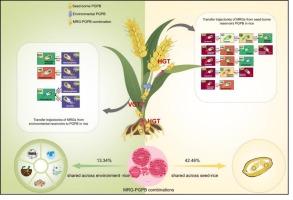水稻中多种抗重金属植物生长促进菌(PGPB)的种子传播和环境传播机制
IF 9.7
1区 环境科学与生态学
Q1 ENVIRONMENTAL SCIENCES
引用次数: 0
摘要
抗重金属植物促生长细菌(PGPB)在缓解重金属胁迫和减少植物重金属积累方面起着至关重要的作用。然而,植物中PGPB及其相关的重金属抗性基因(MRGs)的起源和传播机制尚不清楚。为了填补这一知识空白,我们从重金属污染的稻田中收集了水稻和相关环境样本。从这些水稻和环境样品中回收微生物DNA,然后使用散弹枪宏基因组学在宏基因组组装基因组(MAGs)水平上进行分析。结果表明,在重金属污染条件下,水稻组织及相关环境中检测到805个MRG-PGPB组合。在种子-水稻界面和环境-水稻界面共有的核心MRG-PGPB组合(42.46%)和环境-水稻界面共有的组合(13.34%)共占检测到组合的55.8%,表明环境易位和种子传播垂直传播共同驱动了水稻系统中一半以上的MRG-PGPB定植。随后的来源追踪分析表明,水稻中存在的PGPBs主要来自种子,其中很大一部分也归因于水稻组织内的易位。对优势MRGs的系统发育分析进一步证实了MRGs-PGPB的垂直传播,同时阐明了水稻中携带PGPB的MRGs也可以通过环境或种子MRG-PGPB的水平基因转移(HGT)获得,特别是来自大气微生物(如嗜甲基菌和沙雷氏菌)。这些发现为利用PGPB提高水稻抗重金属污染能力提供了宝贵的见解,从而有助于改善粮食安全和可持续农业做法。本文章由计算机程序翻译,如有差异,请以英文原文为准。

Seed-borne and environmental transmission mechanisms drive diverse heavy metal-resistant plant growth-promoting bacteria (PGPB) in rice
Heavy metal-resistant plant growth-promoting bacteria (PGPB) play a crucial role in mitigating heavy metal stress and reducing heavy metal accumulation in plants. However, the origins and transmission mechanisms of PGPB and their associated heavy metal resistance genes (MRGs) in plants remain unclear. To fill this knowledge gap, we collected rice and related environmental samples from heavy metal-contaminated paddy fields. The microbial DNA was recovered from these rice and environmental samples and then analyzed using shotgun metagenomics at the metagenome-assembled genomes (MAGs) level. As a result, 805 MRG-PGPB combinations were detected in rice tissues and related environments under heavy metal contamination conditions. Core MRG-PGPB combinations shared across seed-rice (42.46%) and environment-rice (13.34%) interfaces collectively constituted 55.8% of the detected combinations, demonstrating that environmental translocation and seed-borne vertical transmission jointly drive over half of MRG-PGPB colonization in rice systems. Subsequent source-tracking analysis indicated that PGPBs present in rice primarily originated from seeds, with a substantial proportion also attributed to translocation within rice tissues. Phylogenetic analysis of dominant MRGs further demonstrated the seed-borne vertical transmission of MRGs-PGPB, while simultaneously elucidating that MRGs harbored by PGPB in rice could also be acquired via horizontal gene transfer (HGT) from environmental or seed-borne MRG-PGPB, particularly from atmospheric microbes such as Methylophilus and Serratia. These findings provide valuable insights into harnessing PGPB to enhance rice resilience against heavy metal contamination, thereby contributing to improved food security and sustainable agricultural practices.
求助全文
通过发布文献求助,成功后即可免费获取论文全文。
去求助
来源期刊

Environment International
环境科学-环境科学
CiteScore
21.90
自引率
3.40%
发文量
734
审稿时长
2.8 months
期刊介绍:
Environmental Health publishes manuscripts focusing on critical aspects of environmental and occupational medicine, including studies in toxicology and epidemiology, to illuminate the human health implications of exposure to environmental hazards. The journal adopts an open-access model and practices open peer review.
It caters to scientists and practitioners across all environmental science domains, directly or indirectly impacting human health and well-being. With a commitment to enhancing the prevention of environmentally-related health risks, Environmental Health serves as a public health journal for the community and scientists engaged in matters of public health significance concerning the environment.
 求助内容:
求助内容: 应助结果提醒方式:
应助结果提醒方式:


